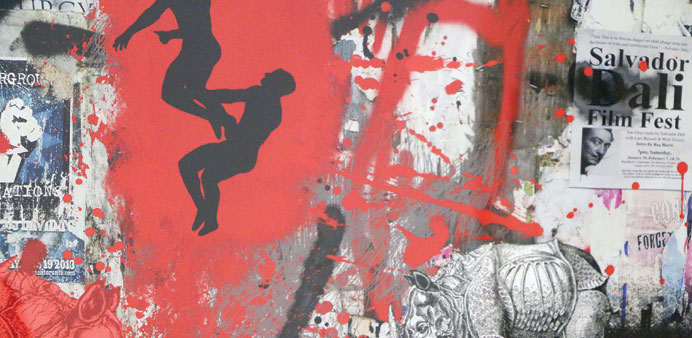Artist Kareem Risan’s solo exhibition at Katara is a depiction of the Iraqi capital in the middle of a conflict. By Umer Nangiana
Since 2003 American invasion of Iraq, Kareem Risan has produced over two dozen art books. Some are bound and can be unfolded, expanded and positioned upright to be viewed in the round, where others comprise separate panels amassed in a portfolio or a box.
According to the introduction in one of his books, during this long period of charting Iraq’s most recent phase of destruction, Risan has chosen to focus on two major points of entry: the walls of Baghdad, ancient and newly erected, and a map of the city as though viewed through the distant perspective of aerial reconnaissance. From the same walls of Baghdad comes one of his solo exhibitions at Katara Art Centre (KAC), titled Memory of Another City.
“My recent paintings are the result of a consecutive, insightful and developed series that complement what I have previously accomplished. They represent wall sections displaying many images: indications, signs and text,” says Risan, explaining the concept of the art pieces showcased at the exhibition in KAC, Building 5.
“Wall paintings and signs were and still are one of humanity’s expressive styles and means by which man could face his daily problems, especially when deprived of the freedom of expression,” says the artist.
Born in Baghdad in 1960, Risan lived and worked in Iraq until 2003 invasion; shortly after, he was forced to flee to Jordan during an especially volatile period of the occupation, and currently resides in Canada.
While in Amman, he was active with a small but significant group of artists and cultural practitioners that often convened at Dar Al-Anda Gallery, a hub for Iraqi artists in exile. He received his artistic training at the Academy of Fine Arts, Baghdad, which frequently shaped the direction of local aesthetics through its faculty of leading painters and sculptors.
“Using digital art, collage, and personal intervention through drawing, Risan is employing his experience to guide us to this city which could be looked at and be acquainted with the light of its scenes that the artist has imagined,” says Saad al-Qassab, Iraqi artist and art critic.
Kareem Risan’s work reflects his experiences of living through war and invasion; he was a soldier during the Gulf War and witnessed the post-2003 US invasion of Iraq. His solo exhibitions include the Museum of Modern Art, Baghdad, 1992; Dar Al-Mashriq Gallery, Amman, 1997; Al-Riwaq Gallery, Bahrain, 2005, and Gallery Hittite, Toronto, 2009.
Risan has also participated in numerous international group exhibitions, including Between the Tigris and Euphrates, Institut du Monde Arabe, Paris, 1988; The Chair Exhibition, Darat Al-Funun, Amman, 1994; Contemporary Iraqi Art, China International Museum, Beijing, 2001; The Broken Letter: Arab Contemporary Artists, Kunst Gallery, Darmstadt, 2003; Dafatir: Contemporary Iraqi Book Art, University of North Texas, Denton, Texas, travelling exhibition, 2005–08; Word into Art, British Museum, London, 2006; Modernism and Iraq, Wallach Art Gallery, Columbia University, New York, 2009; Iraqi Artists in Exile, Station Museum, Houston, Texas, 2009; Beyond the War, LTMH Gallery, New York, 2010, and Art in Iraq Today (with Ghassan Ghaib and Nazar Yahya), Meem Gallery, Dubai, 2010.
Risan’s work is held in the collections of Mathaf: Arab Museum of Modern Art, Doha; Jordan National Gallery of Fine Arts, Amman; Kinda Foundation, Saudi Arabia; British Museum, London, and Athar Gallery, Baghdad.

UNDER SIEGE: Iraqi artist Kareem Risan’s work reflects his experiences of living through war and invasion.
